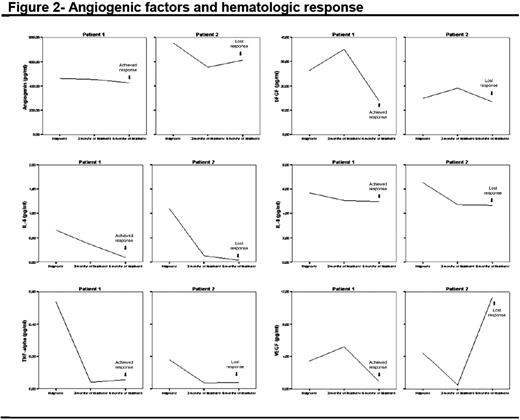Abstract
Abstract 2163
Poster Board II-140
In many cancers including chronic myelogenous leukemia (CML), an increased vascularity inside the tumor microenvironment has been showed recently, which might permit a sufficient blood delivery to the growing neoplastic cells. In fact, angiogenesis might be one of the major factors in the neoplastic process. Although many efforts have been done to elucidate the biological mechanisms of this process in CML, it has not been completely understood. Moreover, the effect of imatinib on some angiogenic factors like angiogenin, IL-6 and IL-8 is poorly known. In order to answer these two questions, we measured angiogenin, IL-6, IL-8, bFGF, TNF-α and VEGF plasma levels in CML patients at diagnosis, 3 and 6 months of imatinib therapy using cytometric bead array (CBA).
Bone marrow microvessel density (MVD) measured in hotspots was evaluated in 17 CML patients at diagnosis and 15 patients with Hodgkin Lymphoma stage IA and IIA (used as controls) by staining immunohistochemically for CD34. Plasma samples from 9 healthy volunteers and 17 CML patients at diagnosis, at 3 and 6 months of treatment (13 patients and 11 patients, respectively) were also analyzed.
The median MVD was higher in CML than Hodgkin Lymphoma patients (p<0.001). IL-6 and VEGF concentration were higher in CML patients than healthy controls (p=0.02, p<0.01, respectively). IL-8 tended to be higher in CML patients (p=0.06) (Figure 1). On the other hand, there was no difference in angiogenin (p=0.43), bFGF (p=0.90) and TNF-α (p=0.45). After 3 months of treatment, there was a clear decrease in IL-6, TNF-α and VEGF (All p<0.001). The reduction of IL-8 was only observed after 6 months of treatment (p=0.02). There was not any tendency of change in angiogenin and bFGF along this period of time. Although IL-6, IL-8 and TNF-α decreased in one patient, who did not achieve a hematologic response at 3 months, the VEGF plasmatic concentration did not reduce. Moreover, in another patient, who lost the hematologic response at 6 months, only VEGF increased again (Figure 2). At diagnosis, IL-6 correlated with the percentage of Philadelphia chromosome in bone marrow (r=0.85, p<0.01) and TNF-α correlated with MVD (r=0.54, p=0.03).
We observed an increased vascularity in the bone marrow of CML patients at diagnosis. IL-6 and VEGF, which were increased at diagnosis, IL-8, which tended to be increased at diagnosis, and TNF-α, which had some correlation with MVD, seem to be involved in the pathophysiology of angiogenesis in CML. Bearing in mind the evolution of the 6 angiogenic factors as according to the hematologic response (Figure 2), VEGF might be a possible target in no-responding patients. In fact, to our knowledge, this is the first study which evaluated these 6 angiogenic factors at diagnosis and after 3 and 6 months of treatment with imatinib.
No relevant conflicts of interest to declare.
Author notes
Asterisk with author names denotes non-ASH members.



This feature is available to Subscribers Only
Sign In or Create an Account Close Modal